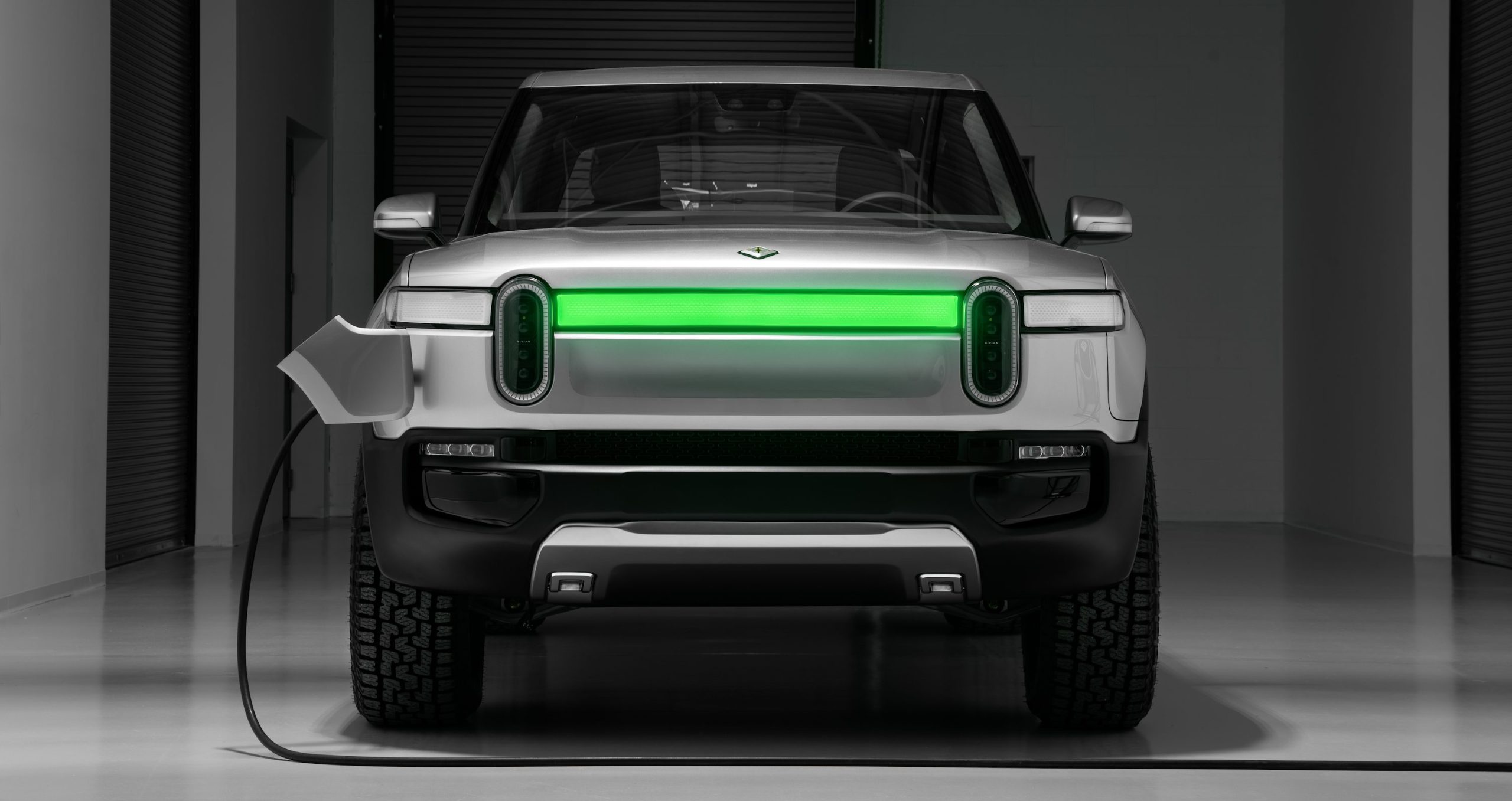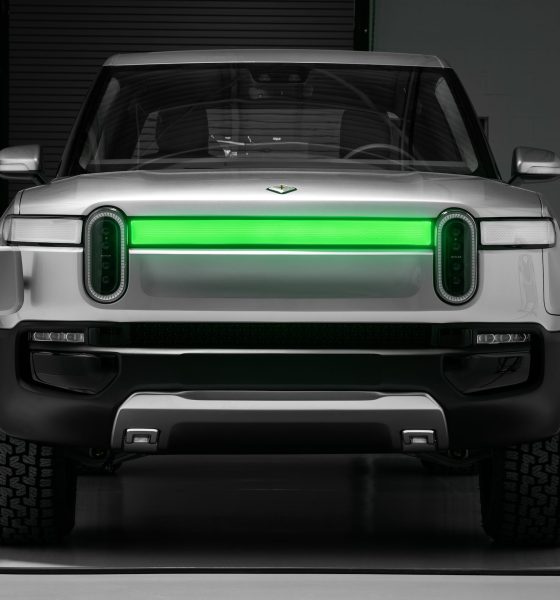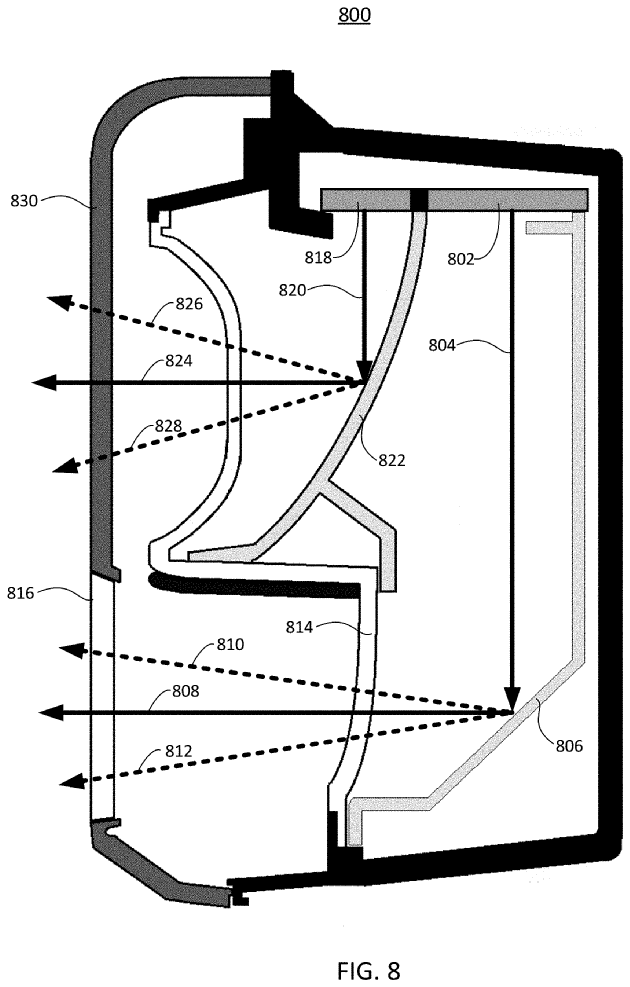

News
Rivian’s color-coded battery charge indicator patent makes charging extra-convenient
Charging electric vehicle batteries is a task that is universal for all EV owners. Electric car makers across different brands have placed their own flourish to make their EV charging system unique, such as Tesla’s lighted indicators for the Model S, X, and Model 3. Electric truck maker Rivian aims to do the same thing, and if a recent patent application is any indication, it appears that the company is looking to make its battery charging indicators extra-convenient and creative at the same time.
There are times when electric car owners will find it difficult to determine the status of their vehicle while its batteries are charging. This is especially true during long trips, when vehicles are parked at public charging stations. If an owner is getting a bite or having a cup of coffee at a cafe, for example, it would be difficult to determine if the vehicle is done charging. Mobile apps showing the status of a vehicle are great, but it would be extra convenient if owners are able to see the status of a charging vehicle at a glance.
This is the central point of Rivian’s recent patent, titled “Exterior Light and Charge Indicator.” Engineers at Rivian believe EV owners should be able to determine the amount of battery charge that their vehicle has from a distance easily. Thus, the company has designed a system using bright LED bulbs that could be seen from across a parking lot or charging station. These LEDs will be integrated into the vehicle itself, as part of its lights.

“It would be advantageous to provide a user with an easy way to read a charge indicator of an electric vehicle. It would also be advantageous to provide a charge indicator that is visible a short or longer distance away from an electric vehicle. It would also be advantageous to utilize existing exterior lighting or lighting areas to provide a charge indicator,” the patent states.
The Rivian R1T pickup truck and R1S SUV are equipped with a long light strip in the middle that’s flanked by two rounded lights. This light strip, as per press images from the electric truck maker, will be used as a primary battery charge indicator if the vehicle is charging. Rivian’s recent patent explains the further use of this light strip in the section below.
“In some embodiments, the lighting control module is configured to cause the exterior light to emit light of a first color (e.g., white) during driving operation of the electric vehicle and emit light of a second color during charging, where the first color is different than the second color (e.g., blue). In some embodiments, the lighting control module is configured to cause the exterior light to emit light of a third color (e.g., green) when the vehicle battery is fully charged. In some embodiments, the lighting control module is configured to cause the exterior light to emit light of a fourth color (e.g., red) when there is a charging fault.”
Such a system would likely give Rivian owners a pretty easy way to determine if their truck or SUV is finished charging, or if there are any issues with the vehicle’s charging session. The fact that the light strip is fairly large works in Rivian’s favor, as there is no doubt that the LEDs would be very visible from a distance.
Another interesting aspect of this new idea is the use of a proximity sensor that could be configured to detect the presence of a person. This sensor would work much like a motion detection system and would light up in the event that a person is within 50 feet of the charging vehicle. It also could utilize a cell phone’s Bluetooth signal to determine when the owner is near. This would then activate the light system that would allow the driver to determine the progress of the charge.
Rivian has released a number of patents within the past few weeks. As the company is gearing up for production of its R1T pickup truck to begin at the tail end of 2020, the Plymouth, Michigan-based company is seemingly putting the final touches on its vehicles before the first units are delivered to reservation holders. Following the R1T, Rivian is also expected to start the production of its seven-seater SUV, the R1S.
The full text of Rivian’s recent color-coded, integrated charging indicator light could be accessed here.

News
Tesla starts showing how FSD will change lives in Europe
Local officials tested the system on narrow country roads and were impressed by FSD’s smooth, human-like driving, with some calling the service a game-changer for everyday life in areas that are far from urban centers.

Tesla has launched Europe’s first public shuttle service using Full Self-Driving (Supervised) in the rural Eifelkreis Bitburg-Prüm region of Germany, demonstrating how the technology can restore independence and mobility for people who struggle with limited transport options.
Local officials tested the system on narrow country roads and were impressed by FSD’s smooth, human-like driving, with some calling the service a game-changer for everyday life in areas that are far from urban centers.
Officials see real impact on rural residents
Arzfeld Mayor Johannes Kuhl and District Administrator Andreas Kruppert personally tested the Tesla shuttle service. This allowed them to see just how well FSD navigated winding lanes and rural roads confidently. Kruppert said, “Autonomous driving sounds like science fiction to many, but we simply see here that it works totally well in rural regions too.” Kuhl, for his part, also noted that FSD “feels like a very experienced driver.”
The pilot complements the area’s “Citizen Bus” program, which provides on-demand rides for elderly residents who can no longer drive themselves. Tesla Europe shared a video of a demonstration of the service, highlighting how FSD gives people their freedom back, even in places where public transport is not as prevalent.
What the Ministry for Economic Affairs and Transport says
Rhineland-Palatinate’s Minister Daniela Schmitt supported the project, praising the collaboration that made this “first of its kind in Europe” possible. As per the ministry, the rural rollout for the service shows FSD’s potential beyond major cities, and it delivers tangible benefits like grocery runs, doctor visits, and social connections for isolated residents.
“Reliable and flexible mobility is especially vital in rural areas. With the launch of a shuttle service using self-driving vehicles (FSD supervised) by Tesla in the Eifelkreis Bitburg-Prüm, an innovative pilot project is now getting underway that complements local community bus services. It is the first project of its kind in Europe.
“The result is a real gain for rural mobility: greater accessibility, more flexibility and tangible benefits for everyday life. A strong signal for innovation, cooperation and future-oriented mobility beyond urban centers,” the ministry wrote in a LinkedIn post.
News
Tesla China quietly posts Robotaxi-related job listing
Tesla China is currently seeking a Low Voltage Electrical Engineer to work on circuit board design for the company’s autonomous vehicles.

Tesla has posted a new job listing in Shanghai explicitly tied to its Robotaxi program, fueling speculation that the company is preparing to launch its dedicated autonomous ride-hailing service in China.
As noted in the listing, Tesla China is currently seeking a Low Voltage Electrical Engineer to work on circuit board design for the company’s autonomous vehicles.
Robotaxi-specific role
The listing, which was shared on social media platform X by industry watcher @tslaming, suggested that Tesla China is looking to fill the role urgently. The job listing itself specifically mentions that the person hired for the role will be working on the Low Voltage Hardware team, which would design the circuit boards that would serve as the nervous system of the Robotaxi.
Key tasks for the role, as indicated in the job listing, include collaboration with PCB layout, firmware, mechanical, program management, and validation teams, among other responsibilities. The role is based in Shanghai.
China Robotaxi launch
China represents a massive potential market for robotaxis, with its dense urban centers and supportive policies in select cities. Tesla has limited permission to roll out FSD in the country, though despite this, its vehicles have been hailed as among the best in the market when it comes to autonomous features. So far, at least, it appears that China supports Tesla’s FSD and Robotaxi rollout.
This was hinted at in November, when Tesla brought the Cybercab to the 8th China International Import Expo (CIIE) in Shanghai, marking the first time that the autonomous two-seater was brought to the Asia-Pacific region. The vehicle, despite not having a release date in China, received a significant amount of interest among the event’s attendees.
Elon Musk
Elon Musk and Tesla AI Director share insights after empty driver seat Robotaxi rides
The executives’ unoccupied tests hint at the rapid progress of Tesla’s unsupervised Robotaxi efforts.

Tesla CEO Elon Musk and AI Director Ashok Elluswamy celebrated Christmas Eve by sharing personal experiences with Robotaxi vehicles that had no safety monitor or occupant in the driver’s seat. Musk described the system’s “perfect driving” around Austin, while Elluswamy posted video from the back seat, calling it “an amazing experience.”
The executives’ unoccupied tests hint at the rapid progress of Tesla’s unsupervised Robotaxi efforts.
Elon and Ashok’s firsthand Robotaxi insights
Prior to Musk and the Tesla AI Director’s posts, sightings of unmanned Teslas navigating public roads were widely shared on social media. One such vehicle was spotted in Austin, Texas, which Elon Musk acknowleged by stating that “Testing is underway with no occupants in the car.”
Based on his Christmas Eve post, Musk seemed to have tested an unmanned Tesla himself. “A Tesla with no safety monitor in the car and me sitting in the passenger seat took me all around Austin on Sunday with perfect driving,” Musk wrote in his post.
Elluswamy responded with a 2-minute video showing himself in the rear of an unmanned Tesla. The video featured the vehicle’s empty front seats, as well as its smooth handling through real-world traffic. He captioned his video with the words, “It’s an amazing experience!”
Towards Unsupervised operations
During an xAI Hackathon earlier this month, Elon Musk mentioned that Tesla owed be removing Safety Monitors from its Robotaxis in Austin in just three weeks. “Unsupervised is pretty much solved at this point. So there will be Tesla Robotaxis operating in Austin with no one in them. Not even anyone in the passenger seat in about three weeks,” he said. Musk echoed similar estimates at the 2025 Annual Shareholder Meeting and the Q3 2025 earnings call.
Considering the insights that were posted Musk and Elluswamy, it does appear that Tesla is working hard towards operating its Robotaxis with no safety monitors. This is quite impressive considering that the service was launched just earlier this year.








